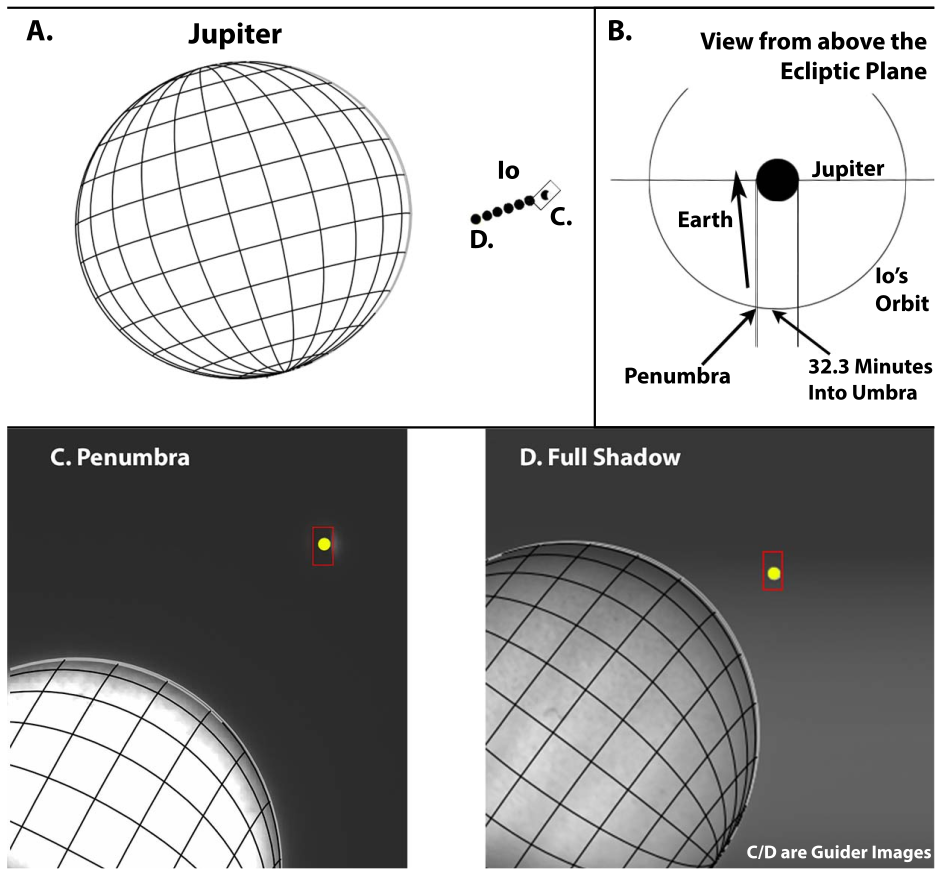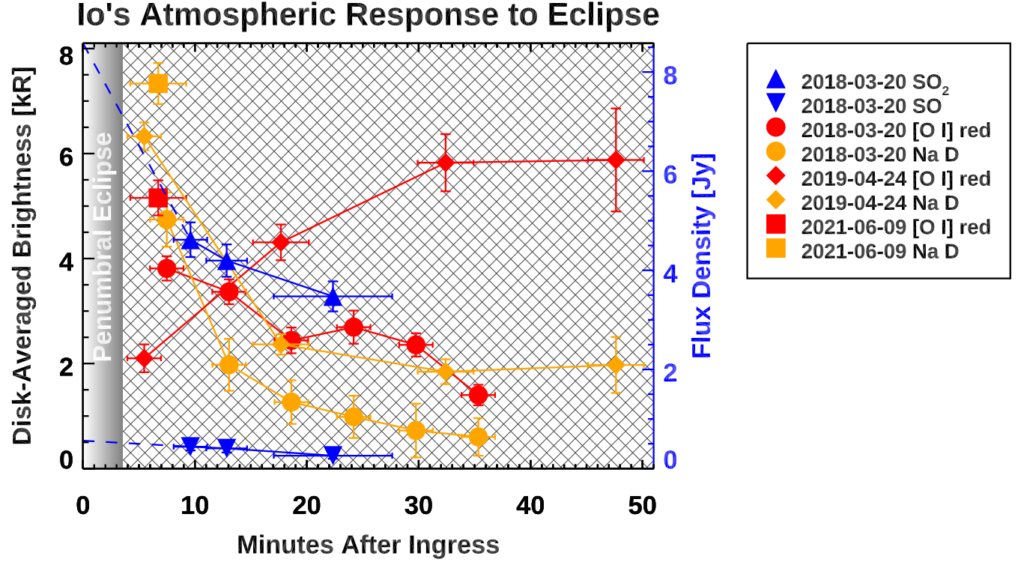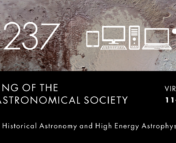Title: Io’s optical Aurorae in Jupiter’s Shadow
Authors: Carl Schmidt, Mikhail Sharov, Katherine de Kleer, Nick Schneider, Imke de Pater, Phillip H. Phipps, Albert Conrad, Luke Moore, Paul Withers, John Spencer, Jeff Morgenthaler, Ilya Ilyin, Klaus Strassmeier, Christian Veillet, John Hill, Mike Brown
First Author’s Institution: Department of Astronomy, Boston University, USA
Status: Available in The Planetary Science Journal, available on the arXiv
Jupiter’s nearest Galilean moon, Io, has a bunch of really weird properties, in addition to looking like a long expired pizza (see also Fig. 1). Io is being pushed and pulled from all sides, not only by Jupiter itself, but also the other Galilean moons, Europa, Ganymede and Callisto. This gives Io some breathtaking tidal effects that make our ocean’s tides look like a few ripples in a pond. These extreme tidal effects cause Io to be very volcanically active, more so than any other object in the Solar system. Here on Earth, volcanos are more or less predictably distributed at the edges of tectonic plates, but on Io they appear randomly over the surface, with no clear patterns. With all this volcanic activity, you would think this would heat up the surface of Io a bit, but no: Io has an average surface temperature of around -130°C. So if you don’t get cooked by randomly erupting volcanoes, the cold won’t be comfortable either. Also, you can’t breathe there, which might be another challenge. Therefore it is best to observe the semi-hellscape surface of Io from afar. There is certainly always enough to see.

Iororae?
Yes, also Io has aurorae (not iororae sadly, missed opportunity there), but they are different from Earth’s. Io’s version is not directly caused by the Sun, but rather by Jupiter’s enormous magnetic field, which is about 20,000 times stronger than Earth’s. Also Earth’s atmosphere is very different from Io’s (luckily). The many volcanoes there spew out large amounts of sulfur dioxide (SO2), which makes up a large part of the atmosphere. This molecule gets shredded by a multitude of processes, releasing electrons and ions all around, causing aurorae to appear and they help form Io’s plasma ring around Jupiter. If we want to know more about this plasma ring and Jupiter’s enormous magnetic field, we need to figure out how the SO2 in Io’s atmosphere behaves and interacts with other molecules and atoms. In daylight, the Sun’s radiation splits up (dissociates) most of the SO2, but what happens to SO2 During night time? There’s no way we can see that without sending very expensive spacecraft up there. Now, as it so happens, Io passes (approximately every 42 hours) through Jupiter’s shadow. During the shadow passage, the surface cools down a lot, and the Sun’s radiation will no longer break down molecules. This closely resembles night time on Io, allowing us to see how the rest of the atmosphere reacts at night, if at all.
There’s a crucial problem when trying to look at Io during the shadow passage: we can’t directly see Io in Jupiter’s shadow. We can still see SO2 by using infrared and millimeter radiation, but the other components in Io’s atmosphere require a more indirect approach, which involves Io’s aurorae. Now, to see these aurorae we mostly need UV, which we can only observe in outer space. Also, probably UV radiation doesn’t tell us everything and there could be more to see with optical light as well. Turns out, Io has impressive aurorae during the Jupiter eclipse as well. The authors of today’s paper managed to see Io’s aurorae in optical light, from ground-based telescopes. Indeed, the authors specifically waited for Io to pass in Jupiter’s shadow as only then are the optical aurorae visible (similarly to here on Earth actually, aurorae aren’t very visible during the day).
Spotting Io’s Aurorae 101
As you might imagine, seeing Io’s aurorae is probably even harder than seeing Earth’s. Most of the time when Io is eclipsed by Jupiter, there’s this giant planet in the way blocking our view. Luckily this is not always the case. When the Sun, the Earth and Jupiter form a right triangle in orbit (fancy Astronomer slang: Earth and Jupiter being at quadrature), we can still ‘see’ Io once it enters Jupiter’s shadow (more fancy Astronomer slang: at ingress) or just before exit (egress). This is shown in Fig. 2, where also the distinction is made between the full shadow (umbra) and the partial shadow (penumbra).

Alright, we have Io in Jupiter’s shadow, now we still need to spot some aurorae as well, and again, Jupiter doesn’t go easy on us. Since these are ground-based observations, Jupiter’s light scatters in the atmosphere, further spoiling the observation. Luckily we know quite well what Jupiter looks like and we can filter out Io’s aurorae, going so far to even single out some very interesting spectral lines of oxygen (O) and sodium (Na). We can now clearly see these lines during the Jupiter eclipse. The intensity of this light shows how much oxygen and sodium is left in the atmosphere. Being observed at three different nights, Fig. 3 shows the O and Na trends during the eclipse, along with the SO2 trend.
It seems oxygen doesn’t really care much about the eclipse at all, doing different things on different dates. How come? The authors claim that the amount of visible oxygen depends on the position of Io in the ring of plasma around Jupiter rather than on whether sunlight reaches Io or not.

On the other hand, Na and SO2 do seem to align, both declining once Io passes into Jupiter’s shadow. To answer that, we need to know that the atomic Na comes mostly from molecules on Io, namely NaCl (a.k.a. salt). Once the eclipse starts, SO2 gas in the atmosphere freezes out as SO2 ice and subsequently falls down on Io’s surface almost like snow (no snow sculptures here though, this stuff is very bad for your health). This snow buries the NaCl on Io, preventing Na from showing up in the spectral lines, hence the decline in Na brightness.
Despite all the difficulties with spotting them, we can nevertheless pull a lot of information from Io’s optical aurorae. Today’s authors demonstrated this by shedding light on the otherwise unobservable night side on Io.
The fact that the authors managed to see Io’s aurorae in the optical and from the ground also opens up the possibility to study Io more frequently, which will undoubtedly lead to more interesting results in the future. Io never fails to surprise!
Astrobite edited by Konstantin Gerbig
Featured image credit: Figure adapted from Bella Graves, NASA, ESA, & J. Nichols (University of Leicester) and NASA/JPL/University of Arizona.




